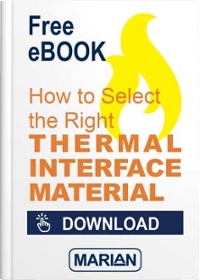Within electronics assemblies, thermal gap pads and thermal grease are utilized to fill in gaps between a heat-generating component and a heat sink to create a clear pathway for heat to escape, keeping the device running at an optimal temperature. So which thermal interface solution is right for your application? To aid in your decision, we list a few pros and cons to both thermal gap pads vs. thermal grease.
Thermal pads
Thermal pads, also known as thermal gap fillers and thermal gap pads, are a pre-formed rectangle or square of solid material. Thermal gap pads are often made of silicone or acrylic that contains a conductive filler. The advantages of thermal gap pads are that they have excellent dimensional stability, which makes them easily die-cut to achieve a consistent shape with each pad. The electronics manufacturer knows exactly what they are going to put into each assembly. The solid thermal gap pads are easy to handle, mess-free, and simple to install, leaving less room for assembly error.
Want to learn more about thermal gap pads? Check out this blog post: The Best Thermal Gap Pad for your Design

Thermal Grease
Thermal grease is also called thermal paste, thermal goop. or thermal compound. It is the original thermal interface material with a proven history. It has high thermal conductivity and can be reworked easily. Thermal grease is also messy and difficult to apply. Application uniformity is often difficult to achieve during manufacturing, leaving more room for error and inconsistency.

Marian manufactures precision die cut components for the electronics industry. Marian sales engineers can help design and manufacture thermal management materials, including thermal gap pads, thermal transfer tapes, phase change materials, heat spreader foils, and foam elastomers. Contact us to discuss your application.
Want to learn more about Thermal Interface Materials?
Try the free downloads below:





